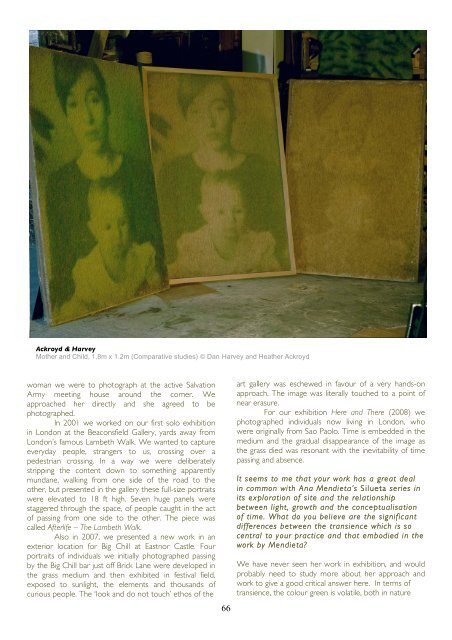M - Antennae The Journal of Nature in Visual Culture
M - Antennae The Journal of Nature in Visual Culture
M - Antennae The Journal of Nature in Visual Culture
Create successful ePaper yourself
Turn your PDF publications into a flip-book with our unique Google optimized e-Paper software.
Ackroyd & Harvey<br />
Mother and Child, 1.8m x 1.2m (Comparative studies) � Dan Harvey and Heather Ackroyd<br />
woman we were to photograph at the active Salvation<br />
Army meet<strong>in</strong>g house around the corner. We<br />
approached her directly and she agreed to be<br />
photographed.<br />
In 2001 we worked on our first solo exhibition<br />
<strong>in</strong> London at the Beaconsfield Gallery, yards away from<br />
London’s famous Lambeth Walk. We wanted to capture<br />
everyday people, strangers to us, cross<strong>in</strong>g over a<br />
pedestrian cross<strong>in</strong>g. In a way we were deliberately<br />
stripp<strong>in</strong>g the content down to someth<strong>in</strong>g apparently<br />
mundane, walk<strong>in</strong>g from one side <strong>of</strong> the road to the<br />
other, but presented <strong>in</strong> the gallery these full-size portraits<br />
were elevated to 18 ft high. Seven huge panels were<br />
staggered through the space, <strong>of</strong> people caught <strong>in</strong> the act<br />
<strong>of</strong> pass<strong>in</strong>g from one side to the other. <strong>The</strong> piece was<br />
called Afterlife – <strong>The</strong> Lambeth Walk.<br />
Also <strong>in</strong> 2007, we presented a new work <strong>in</strong> an<br />
exterior location for Big Chill at Eastnor Castle. Four<br />
portraits <strong>of</strong> <strong>in</strong>dividuals we <strong>in</strong>itially photographed pass<strong>in</strong>g<br />
by the Big Chill bar just <strong>of</strong>f Brick Lane were developed <strong>in</strong><br />
the grass medium and then exhibited <strong>in</strong> festival field,<br />
exposed to sunlight, the elements and thousands <strong>of</strong><br />
curious people. <strong>The</strong> ‘look and do not touch’ ethos <strong>of</strong> the<br />
66<br />
art gallery was eschewed <strong>in</strong> favour <strong>of</strong> a very hands-on<br />
approach. <strong>The</strong> image was literally touched to a po<strong>in</strong>t <strong>of</strong><br />
near erasure.<br />
For our exhibition Here and <strong>The</strong>re (2008) we<br />
photographed <strong>in</strong>dividuals now liv<strong>in</strong>g <strong>in</strong> London, who<br />
were orig<strong>in</strong>ally from Sao Paolo. Time is embedded <strong>in</strong> the<br />
medium and the gradual disappearance <strong>of</strong> the image as<br />
the grass died was resonant with the <strong>in</strong>evitability <strong>of</strong> time<br />
pass<strong>in</strong>g and absence.<br />
It seems to me that your work has a great deal<br />
<strong>in</strong> common with Ana Mendieta’s Silueta series <strong>in</strong><br />
its exploration <strong>of</strong> site and the relationship<br />
between light, growth and the conceptualisation<br />
<strong>of</strong> time. What do you believe are the significant<br />
differences between the transience which is so<br />
central to your practice and that embodied <strong>in</strong> the<br />
work by Mendieta?<br />
We have never seen her work <strong>in</strong> exhibition, and would<br />
probably need to study more about her approach and<br />
work to give a good critical answer here. In terms <strong>of</strong><br />
transience, the colour green is volatile, both <strong>in</strong> nature












